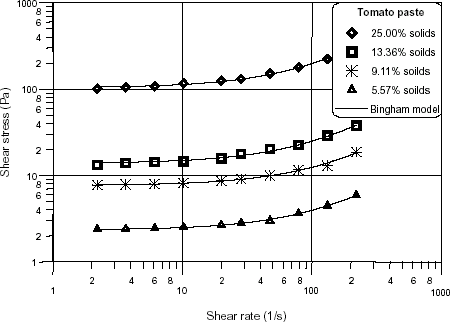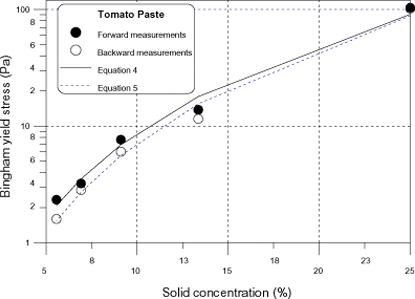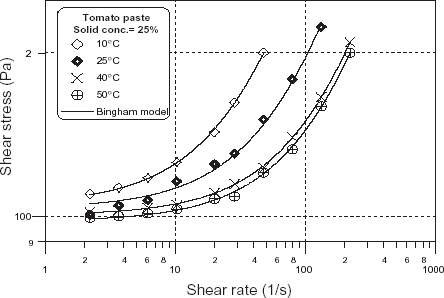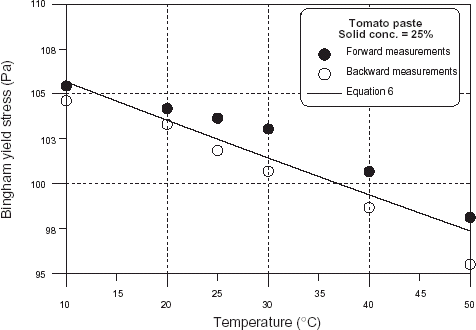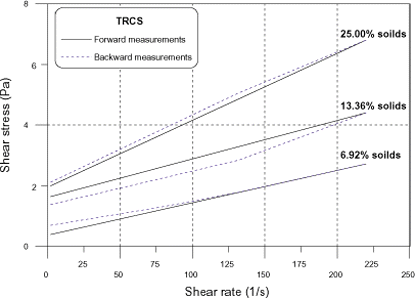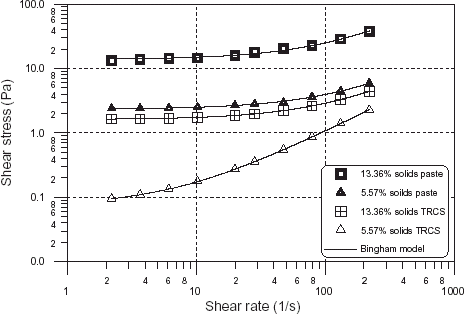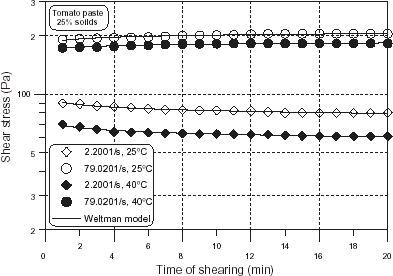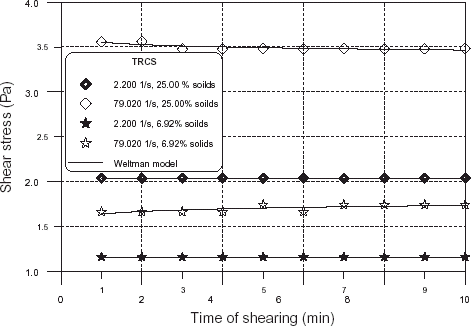Abstract
The flow curves and time-dependent flow properties of tomato paste and tomato reconstituted solution (TRCS) were assessed in this study at different concentrations and temperatures. The tomato-reconstituted solution was prepared by dissolving the powders (produced by the spray drying technique) in certain amount of water to provide the concentration required. Bingham model was found to be the most appropriate to fit the flow curves of tomato paste. The yield stress, τ B , significantly increased with concentration and decreased with temperature in both the forward- (increasing shear rate) and backward-measurements (decreasing shear rate). The Bingham viscosity, η B , was found to increase with concentration and decrease with temperature. As for the TRCS, the flow curves were also best fitted by the Bingham model with shear stress values significantly less than that of tomato paste at the same concentration and shear rate. Tomato paste solutions showed a time-dependent rheological behavior while the TRCS showed a time-independent behavior. Tomato paste exhibited a thixotropic behavior at low shear rates and converted to an anti-thixotropic behavior at high shear rates.
Introduction
Tomato (Lycopersicum esculentum), the “King of Vegetables,” is grown worldwide on a variety of soils and climate conditions. United States, Turkey, Italy, and Spain are the leading tomato growing countries.Citation1 Jordan produces about 0.3 million metric ton per year. Tomato is a good source of vitamins and minerals. Lycopene, the predominant carotenoid pigment of tomato contributes to its characteristic red color. It functions as an anti-oxidant and helps in lowering DNA damage. These properties have accelerated research activities to improve processing factors that lead to maintain the nutritional as well as sensory quality of tomato product. Nutritional and sensory quality of tomato products are primarily affected by fruit cultivator, growing conditions, and processing parameters.Citation2
Millions tonnes of tomatoes are produced each year. Majority of these are processed as tomato paste. Tomato powder promises a specialist market due to many advantages, including ease of packing, transportation and mixing, and no-drum clinging losses.Citation3 In addition, tomato powder is much in demand by dehydrated soup manufacturers. It is now produced in many countries where tomatoes are an indigenous outdoor crop.Citation4
Rheological properties of food products are important in quality control, storage and processing, stability measurements, and in predicting texture. Rheological studies become particularly useful when predictive relationships for rheological properties of food can be developed starting from the molecular architecture of the constituent species.Citation5 In addition, reliable and accurate steady rheological data are necessary for: (1) the design of continuous-flow processes such as sizing of pumps and other fluid-moving machinery; (2) evaluating heating and cooling rates during processing; and (3) estimating velocity, shear and residence-time distribution in extrusion and continuous mixing.Citation5
Harper and El SharigiCitation6 measured the viscosity of tomato juice at a single value of shear rate (500 s−1). A relationship relating the apparent viscosity to the concentration and temperature of tomato juice has been derived. Rao et al.Citation7 have investigated the effect of cultivars on the rheological properties of tomato concentrates. De Kee et al.Citation8 have reported that the viscosity–shear rate data for tomato juice exhibit a “discontinuity” at a shear rate in the vicinity of 1000 s−1, suggesting the importance of determining the critical shear rate beyond which cells are probably broken down, as opposed to simply being deformed. The effect of break temperature and holding time on pectin and pectic enzymes in tomato pulp has also been studied by Luh and Daoud.Citation9 It was found that the gross viscosity and serum viscosity of the canned tomato pulp increased as break temperature increased and this was related to total pectin of the tomato pulp as well as the total pectin in the serum. Viscosity and total pectins also increased as holding time increased. This was thought to be due to the inactivation of pectic enzymes at high break temperature and longer holding times.
Tanglertpaibul and RaoCitation10 have studied the shear rate–shear stress data of a 20% total solids tomato concentrate at different particle sizes. The particle size range was from 0.508–11.43-mm screen. It was found that in general smaller particle size distribution yield, lower apparent viscosities. However, the concentrates from 0.686-mm, screen had the highest apparent viscosity among the four screen sizes studied. The observed influence of screen size was attributed to the small screens which reduced the size of the particles.
Few studies considered the time-dependent rheological behavior of tomato products. For example, Vercet et al.Citation11 studied the effects of manothermosonication (MTS) and conventional thermal treatment (TT) on tomato juice rheology. The flow curves yield stress and apparent viscosity were measured for the two samples. Both samples show a thixotropic behavior when sheared at a rate of 99 s−1 for 5 min. The results of their study suggested that MTS could be considered a useful technology to obtain high viscosity tomato juice.
The objective of this work was to determine and compare the rheological properties of tomato powder reconstituted to that of tomato paste solutions. Tomato powder was preproduced using the spray drying technique. The effect of operating conditions such as initial solids content, solution temperature, and shearing conditions were investigated.
Materials and Methods
Tomato Paste
The tomato paste (Al-Kaseeh Company, Jordan), which contains 25% solids, bought from the local market, was used in the experiments. It was diluted to the required concentration by addition of distilled water.
Tomato Reconstituted Solution
The solution was prepared by adding spray dried tomato powder to water to achieve the concentration required. The particle size range of the powder was from 1.65 to 8.93 µm. The procedure for obtaining tomato powder by the spray drying technique has been presented elsewhere.Citation12 Citation13
Viscometer
Rheological properties measurements of tomato paste and reconstituted solution were conducted using a rotational, concentric cylinder viscometer (Searle-type, Haake VT500/MV3) with a fixed outer cylinder and a rotating measuring bob. The radius, length, and gap width of the rotating cylinder were 15.2, 60, and 5.8 mm, respectively.
Methodology
Tomato paste or tomato powder reconstituted solutions with a solid content ranging from 5.57 to 25 wt% solids were prepared. The solution was placed within the annulus of the concentric cylinders of the viscometer. The test was carried out after attaining thermal equilibrium. The apparent viscosity, η, was measured as a function of shear rate, . The shear rate was varied between 2.2 and 219.8 s−1. The shear stress, τ, was calculated using:
The flow curves of tomato paste and tomato reconstituted solution were analyzed using the Bingham modelCitation5:
To study the effect of temperature on the rheological properties of tomato paste, samples of 25% solids paste were maintained at rest for 15 min in the viscometer to equilibrate with the experimental temperature of 10, 20, 25, 30, 40, or 50°C, before conducting the measurements. Temperature of the viscometer was controlled using thermostatic circulating water bath. The experiments were duplicated and the average results are reported here. The reproducibility of the experiments was within ±3%.
It should be mentioned that the tomato powder reconstituted solution was well mixed before conducting the rheological tests, and therefore the observed settling rate was very low. In addition, no slip conditions were observed when different measuring systems of the viscometer with different gap widths were used in order to investigate if slip conditions do present.
Results and Discussion
Flow Curves
The flow curves (τ vs. ) of tomato paste were measured at different solid concentrations namely: 5.57, 6.92, 9.11, 13.36, and 25 wt% in both forward (increasing shear rate) and backward (decreasing shear rate) directions. All samples showed a non-Newtonian behavior; i.e., the relationship between τ and
is nonlinear. The non-Newtonian behavior of tomato paste can be attributed to the presence of high molecular weight materials such as pectins. The presence of some hysterises loops in the flow curves is an indication of shearing effects on the molecular structure of tomato paste. This resulted in a decrease in the apparent viscosity. The hysterises loops indicate that the degree of thixotropy (if present) is small. However, the hysteresis loops of the flow curves cannot be used quantitatively to determine the effect of solid concentration on the thixotropic behavior of tomato paste.
The flow curves of tomato paste in both directions reflect Bingham behavior (Eq. (Equation2)). Figure shows the flow curves of tomato paste at different solid concentrations measured in the forward direction. The Bingham model as shown by the solid lines (Fig. ) fits well the data. Tanglertpaibul and RaoCitation10 used the Herschel-Bulkely model () to fit the flow curves of tomato juice. The Bingham model is a special case of Herschel-Bulkely model with n = 1. Other rheological models, such as power-law model, was tested, but had not adequately fit the flow curves.
Table displays the regressed parameters τ B and η B for the measurements in both forward and backward directions. As expected both τ B and η B increase with concentration; as higher concentrations have higher resistance to shearing compared to lower concentrations. It is noteworthy to mention that the calculated values of the yield stress are comparable with the values reported by other investigators for the tomato paste.Citation10 Citation11
Table 1 Bingham model parameters of tomato paste (TP) and tomato reconstituted solution (TRCS) at different values of concentration and at T = 25°C
It can be also seen (Table ), that the yield stress, τ B , in the forward measurements was higher than that in the backward ones with small differences. This is notable for all solid concentrations. However, the backward measurements showed greater values of η B . Nonetheless, the above results alone cannot confirm if tomato paste has a thixotropic behavior.
Figure shows the concentration-dependence of the yield stress, τ B , for both forward and backward measurements. In the forward direction, the effect of concentration on τ B can be best described by the following empirical equation:
As expected, τ B approaches zero as the concentration in Eqs. (Equation4) and (Equation5) approaches zero, i.e., pure water, thus Bingham model reduces to a Newtonian flow model. The flow curves of tomato paste at different temperatures (10–50°C) measured in the forward direction are presented in Fig. . The data were also fitted to the Bingham model (solid lines). The parameters of Bingham model, τ B and η B , at different temperatures are displayed in Table .
Table 2 Bingham model parameters of tomato paste at different temperatures and solid concentration of 25%
Obviously, the yield stress, τ B and the Bingham viscosity η B decrease with increasing temperature. However, significant reduction in η B with temperature is noted. The temperature-dependence of the yield stress, τ B , for the forward and backward measurements is given in Fig. . The data of Fig. were fitted to the equation τ B = Ae bT , where T is the temperature (°C), and the following form was obtained for both the forward and backward measurements:
Figure provides the flow curves of tomato-reconstituted solution (TRCS) at three different concentrations, in the forward and in the backward directions. An anti-thixotropic behavior can be observed at low and high concentrations. On the other hand, the intermediate concentration shows a thixotropic behavior. Such contrary behavior deserves further examination as will be shown later. The Bingham model was used to fit the relationship between τ and for the TRCS. The parameters τ
B
and η
B
are also provided in Table . It is clear that the TRCS exhibited a Newtonian behavior at low solid concentrations (τ
B
= 0). In addition, small τ
B
values were observed at high concentrations. The results reported in Table led to the conclusion that the tomato paste posses a higher yield stress and higher Bingham viscosity than the TRCS. This remarkable difference is due to the big difference in the particle size. While the particle size of the TRCS ranged between 1.65 and 8.93 µm, the tomato paste consists of suspended particles in a colloidal serum with most of the particles above 150 µm in size.Citation16
The previous findings are supported by Fig. , which shows a comparison between the flow curves of tomato paste and tomato reconstituted solution at the same solid concentration. The shear stress of the reconstituted solution is clearly smaller than that of the tomato paste at the same shear rate. This can be explained by the fact that heat (due to spray drying) alters the structure of pectic substances by means of hydrolysis. Pectic substances and other long chain carbohydrate polymers can be hydrolyzed by heat resulting in smaller molecules. Colloidal properties then may be altered by the heat treatment resulting in lower apparent viscosity of reconstituted tomato concentrates.Citation10 Harper and El SahrigiCitation6 found that the apparent viscosity of the reconstituted sample was only about one-third of that of the corresponding original concentrate.
Time-Dependant Flow Properties
Tomato paste and TRCS samples were sheared at different values of constant shear rate for a period of 20 min. The Weltman model (Eq. (Equation3)) was used to fit the shear stress–time data. Table displays the constants of the Weltman model evaluated at different solid concentrations for both tomato paste and TRCS. The negative values of B reflect the thixotropic behavior, while the positive values of B reflect the anti-thixotropic behavior. However, the values of B reported in Table are, in general, very small, this means that the time-dependent behavior of tomato pastes is not significant. This behavior is illustrated in Fig. where the effect of shear rate on the time-dependent behavior of the paste at 25% solid content is presented. It can be seen (Fig. ) that shear stress varies slightly with time. The results of Table indicate that at low shear rates, 2.2 and 6.116 s−1, the paste exhibited a thixotropic behavior; while at higher values of shear rate, 28.38 and 79.02 s−1, the paste behaved like an anti-thixotropic material. Such behavior was more obvious at the high solid contents than at the lower ones (see Table ). Similar observations were reported by De Kee et al.Citation8 Vercet et al.Citation11 also found that tomato paste exhibits a thixotropic behavior when the samples were sheared at 99 s−1 for 5 min.
Table 3 The parameters of the Weltman model evaluated at different concentrations of tomato paste (TP) and tomato reconstituted solution (TRCS), at T = 25°C
Figure 7. Effect of shear rate on the transient shear stress of 25-wt% solid content tomato paste at 25°C.
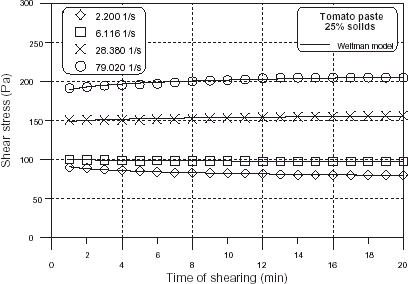
Table shows the parameters of Weltman model for the 25-wt% paste evaluated at different temperatures. As in the case of solid concentration effect, the shear stress was dependent on time at all share rates tested (Fig. ). At low values of shear rate, 2.2 and 6.116 s−1, the shear stress decreased and reached an equilibrium value (thixotropic behavior); while at higher values of shear rate, 28.38 and 79.02 s−1 the shear stress increased with time before it became steady (anti-thixotropic behavior). These behaviors were noticed at all temperatures investigated. However, the degree of thixotropy (at a fixed shear rate value) increased with temperature as indicated by the values of B presented in Table .
Table 4 The parameters of the Weltman model evaluated for tomato paste at different temperatures and at solid concentration of 25%
On the other hand, the tomato-reconstituted solutions at different solid concentrations showed a time-independent rheological behavior, when sheared at different constant shear rates (Fig. ). The parameters of the Weltman model evaluated at different tomato reconstituted solution concentrations are presented in Table . It is clear that the B values are very small and approach zero (the time-independent behavior). Although, in the hysteresis loop results (Fig. ) both a thixotropic and anti-thixotropic behavior were observed, in the steady shearing experiments such behavior was not noted. Most likely, a phase separation process took place in the first experiment and resulted in the observed hysteresis loop. The small difference between the forward and backward measurements could be attributed to the experimental error in the viscometer readings. A comparison between B values for tomato paste and that of tomato reconstituted solution show that the reconstituted solution has much lower B values than that of paste at the same concentration and shear rate. Again, the values of A of the TRCS were lower than those of the paste confirming that the viscosity of the paste solutions is usually higher than those of the TRCS solutions. The heat given up in the spray dryer caused structural changes of tomato pectic substances by means of hydrolysis and thus altered the paste rheological characteristics.
Conclusions
Tomato paste exhibited a non-Newtonian behavior with a yield stress. The Bingham model was used to fit the flow curves of tomato paste at different concentrations and temperatures. The yield stress decreased with increasing the temperature as well as with decreasing the solid content. Empirical models were proposed to show the dependence of the yield stress on tomato paste temperature and solid content. At low solid content, the tomato reconstituted solutions TRCS exhibited a Newtonian behavior while at high solid contents the solutions exhibited a Bingham plastic behavior. Under similar conditions of total solid content and shear rate, the shear stress values of tomato paste were usually higher than those of the TRCS. Tomato paste exhibited a thixotropic behavior at low shear rate and changed to an anti-thixotropic behavior at high shear rate, regardless of the temperature and solid content. On the other hand, the transient shear stress data of TRCS showed a time-independent behavior.
References
- Sogi , D.S. , Kiran , J. and Bawa , A.S. 1999 . Characterization and utilization of tomato seed oil from tomato processing waste . Food Science and Technology , 36 : 248 – 249 .
- Kaur , C. , Khurdiya , D.S. , Paul , R.K. and Kapoor , H.C. 1999 . Effect of microwave heating and conventional processing of nutritional qualities of tomato juices . Food Science and Technology , 36 : 331 – 333 .
- Masters , K. 1985 . Spray Drying Handbook, , 4th Ed. New York : John Wiley and Sons .
- Greensmith , M. 1998 . Practical Dehydration, , 2nd Ed. England : CRC Press .
- Heldman , D.R. and Lund , D.B. 1992 . Handbook of Food Engineering New York : Marcel Dekker, Inc. .
- Harper , J.C. and El Sharigi , A.F. 1965 . Viscometeric behavior of tomato concentrates . Journal of Food Science , 30 : 470 – 475 .
- Rao , M.A. , Bourne , M.C. and Cooley , H.J. 1981 . Flow properties of tomato concentrates . Journal of Texture Studies , 12 : 521 – 538 .
- De Kee , D. , Code , R.K. and Turcotte , G. 1983 . Flow properties of time-dependent foodstuffs . Journal of Rheology , 27 : 581 – 604 . [CROSSREF]
- Luh , B.S. and Daoud , H.N. 1971 . Effect of break temperature and holding time on pectin and pectic enzyme in tomato pulp . Journal of Food Science , 36 : 1039 – 1043 .
- Tanglertpaibul , N.S. and Rao , M.A. 1987 . Rheological properties of tomato concentrates as affected by particle size and method of concentration . Journal of Food Science , 52 : 141 – 145 .
- Vercet , A. , Sanchez , C. , Burgos , J. , Montanes , L. and Lopez , P. 2002 . The effect of manothermosonication on tomato pectic enzymes and tomato paste rheological properties . Journal of Food Engineering , 53 : 273 – 278 . [CROSSREF]
- Banat , F. , Jumah , R. , Al-Asheh , S. and Hammad , S. 2002 . Effect of operating parameters on the spray drying of tomato paste . Engineering in Life Science , 2 : 403 – 407 . [CROSSREF]
- Jumah , R. , Banat , F. , Al-Asheh , S. and Hammad , S. 2003 . Drying kinetics of tomato paste . International Journal of Food Properties , In press
- Weltman , R.N. 1943 . Breakdown of thixotropic structure as a function of time . Journal of Applied Physics , 14 : 343 – 350 .
- Tejinder , S. , Sukhvinder , S. , Bhupinder , K. , Harinder , K. and Saini , S.P.S. 1999 . Flow properties and physico-chemical characteristics of “Perlett” grape juice concentrates . Food Science and Technology , 36 : 402 – 407 .
- Hayes , W.A. , Smith , P.G. and Morris , A.E.J. 1998 . The production and quality of tomato concentrates . Critical Reviews in Food Science and Nutrition , 38 : 537 – 564 .
